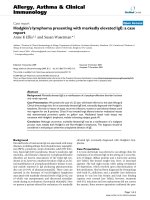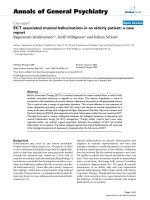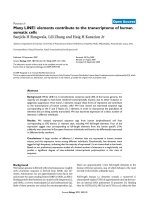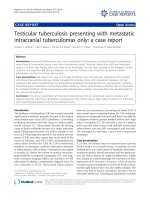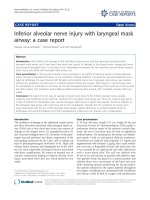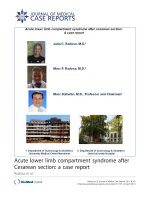Báo cáo y học: "Severe leukocytoclastic vasculitis secondary to the use of a naproxen and requiring amputation: a case report" ppt
Bạn đang xem bản rút gọn của tài liệu. Xem và tải ngay bản đầy đủ của tài liệu tại đây (611.69 KB, 7 trang )
JOURNAL OF MEDICAL
CASE REPORTS
Brown et al. Journal of Medical Case Reports 2010, 4:204
/>Open Access
CASE REPORT
© 2010 Brown et al; licensee BioMed Central Ltd. This is an Open Access article distributed under the terms of the Creative Commons
Attribution License ( which permits unrestricted use, distribution, and reproduction in
any medium, provided the original work is properly cited.
Case report
Severe leukocytoclastic vasculitis secondary to the
use of a naproxen and requiring amputation: a case
report
Keri Brown*, Jeanine Martin and Susan Zito
Abstract
Introduction: Leukocytoclastic vasculitis (also known as hypersensitivity vasculitis and cutaneous necrotizing
vasculitis) can present with various manifestations, which often delays the diagnosis and treatment. In order to show
the importance of the early recognition of leukocytoclastic vasculitis, we present a case which occurred secondary to
the use of a common pharmaceutical, naproxen. We were unable to find a case of leukocytoclastic vasculitis secondary
to naproxen in the literature.
Case presentation: We present the case of a 33-year-old African American woman with below the knee and bilateral
digital gangrene from hypersensitivity vasculitis secondary to the non-steroidal anti-inflammatory medication
naproxen.
Conclusion: This is an original case report focusing on the rheumatologic management of leukocytoclastic vasculitis.
However, other specialties, such as internal medicine, dermatology, infectious disease, general surgery and pathology,
can gain valuable information by reviewing this case report. Reporting a case of leukocytoclastic vasculitis secondary
to treatment with naproxen will advance our understanding of this disease etiology by adding yet another non-
steroidal anti-inflammatory drug to the list of potential causes of leukocytoclastic vasculitis.
Introduction
The term leukocytoclastic vasculitis (LCV) has been used
interchangeably with other descriptions of small-vessel
vasculitides, including drug-induced vasculitis, allergic
vasculitis, hypersensitivity angiitis, and hypersensitivity
vasculitis (HSV) [1]. Leucocytoclastic angiitis is an iso-
lated condition without systemic vasculitis or glomerulo-
nephritis [2,3]. The American College of Rheumatology
(ACR) has developed criteria for the classification of
hypersensitivy vasculitis [4,1]. When used diagnostically
the positive predictive value of these criteria is only ~30%
[1]. In addition, other limitations include the lack of dif-
ferentiation of hypersensitivity vasculitis from Henoch-
Schönlein purpura (HSP) [1]. Michel et al. proposed a
different classification methodology using the same data-
base of patients with vasculitis as that used for the ACR
criteria to differentiate HSV from HSP [1]. Using this
classification, the presence of three or more of these cri-
teria (see Additional File 1), has a sensitivity of 71% and a
specificity of 84% for the diagnosis of HSV [1].
The inflammation of small blood vessels, most com-
monly postcapillary venules, is the cardinal histologic fea-
ture of LCV [1]. Other characteristic features include
fibrinoid necrosis of the vessel walls, leukocytoclasis, and
hemorrhage [1,3]. The inflammatory infiltrate is typically
neutrophilic; other studies have shown a predominance
of mononuclear cells and eosinophils distributed in all
vessel layers [1]. Direct immunofluorescence has been
detected in LCV, in which early stages of vascular injury
have fibrinogen, C3, and immunoglobulin M deposits
have been detected in the vessel wall [1]. In fully manifest
lesions, albumin, fibrinogen, and IgG deposits are pres-
ent; lesions at later stages have fibrinogen and C3 depos-
ited in vessel walls [1,5]. The severity of the lesion may
correlate with disease course [1]. The presence of palpa-
ble purpura correlates with a greater depth of inflamma-
tory infiltrate and self-limited disease [1,6]. However,
vessel wall inflammation was not associated with the
presence or absence of systemic vasculitis [1].
* Correspondence:
1
HCA Largo Medical Center, Indian Rocks Road, Largo, Florida, 33774, USA
Full list of author information is available at the end of the article
Brown et al. Journal of Medical Case Reports 2010, 4:204
/>Page 2 of 7
The skin is the most commonly involved organ in LCV,
predominantly in the lower extremities [1,7,8]. Up to one-
third of patients have trunk and upper extremity involve-
ment, typically sparing the palmar, plantar, and mucosal
surfaces [1,8]. The most common skin manifestation and
the most sensitive finding of HSV is palpable purpura
[1,7,8]. Other skin manifestations include maculopapular
rash, bullae, papules, plaques, nodules, ulcers, and livedo
reticularis [1,8]. Other manifestations of LCV include
joint involvement [1,8]. Some patients may have arthral-
gias or arthritis as the presenting symptom, usually oli-
goarthritis of the knees or ankles [1,8]. Systemic
manifestations of LCV are much less common than its
dermatologic features. These include fever, microscopic
hematuria, elevated creatinine, pericarditis and pleuritis
[1,9].
Laboratory data in the evaluation of LCV is useful in
excluding other vasculitides, but there is no specific labo-
ratory test for LCV [1]. Elevation of erythrocyte sedimen-
tation rate (ESR) is often seen in HSV [1,8]. A small
amount of patients will have anemia, while complement
levels are typically normal in LCV [1,8]. Most patients
with LCV will have negative antinuclear antibodies, rheu-
matoid factors, antibodies to human immunodeficiency
virus (HIV), antinuclear cytoplasmic antibodies, and
cryoglobulins [1,7,8].
In the pathogenesis of HSV, circulating immune com-
plexes with soluble antigens, either intrinsic or extrinsic,
are deposited into vessel walls and activate the classic and
alternative complement pathways [1]. HSV is thought to
occur through this mechanism with a drug acting as a
hapten and stimulating an immune response [1,10].
Numerous series and case reports have reported drugs
as the precipitating agent in LCV [1,8,11]. In patients
with biopsy proven LCV, 24% had drug exposure within a
week of presentation [1,7]. There are many drugs that
have been implicated in the development of LCV includ-
ing antibiotics, non-steroidal anti-inflammatory drugs
(NSAIDs), methotrexate, azathioprine, etanercept,
cyclosporine, allopurinol, sulfasalazine, gold salts, anti-
thyroid agents, anticonvulsants, antiarrhythmics, and
diuretics [1]. Most cases of LCV are self-limited, lasting
several weeks to months [1,11]. One study showed that
90% of patients with HSV had resolution of symptoms in
less than one year [1,8]. Also, most patients with LCV
have complete recovery without sequelae [1,7]. Most
patients with an acute episode of HSV do not require
treatment [1]. Patients with an identifiable precipitating
etiology have outcomes similar to that of patients without
a known trigger [1,8]. Patients with palpable purpura
have a better disease outcome and course, as compared to
patients with vasculitic skin ulcers [1,6].
The treatment of HSV includes discontinuing any caus-
ative medication [1]. If the identification of a single drug
is not possible then there should be an attempt to with-
draw as many suspected etiologies as possible [1]. Agents
involved in the treatment of LCV are NSAIDs, colchicine,
dapsone, corticosteroids, cyclophosphamide, azathio-
prine, plasma exchange, and intravenous immune globu-
lin [1].
Case presentation
A 33-year-old African American woman presented to the
emergency medical services of our hospital complaining
of a chest pain that began suddenly that morning while
she was resting in bed. She described the chest pain as
sharp and non-radiating in the peristernal area. Deep
breaths and movement exacerbated her chest pain. Nitro-
glycerin given sublingually partially relieved the pain. On
initial presentation she also complained of right foot pain
progressively worsening over the past five days. She also
admitted to bilateral hand pain worsening over the past
three days. The right foot pain prompted an emergency
room visit one week prior to this admission for which she
was treated with naproxen [Naprosyn] and propoxyphene
and acetaminophen [Darvocet], which gave her minimal
relief of the pain in her right foot.
Her medical history is significant only for normal child-
hood illnesses. Her surgical history only includes a cesar-
ean section. Socially she admitted to drinking two bottles
of beer on a daily basis but denied tobacco or drug use.
Her father died at the age of 46 secondary to a myocardial
infarction, and her mother is alive with hypercholester-
olemia, diabetes, hypertension and arthritis. She also has
a brother with diabetes. She denies food, drug or environ-
mental allergies. Her home medication includes
naproxen and propoxyphene and acetaminophen, which
were prescribed to her one week prior to this admission.
On initial physical examination she was noted as having
violaceous purpuric patches and macules that were non-
palpable, non-blanchable lesions distributed bilaterally
over her hands and right foot. These lesions were consis-
tent with vasculitis or arterial insufficiency. Her toes and
midfoot were completely involved in a stocking pattern
with sparing at the heel. Her ankle to middle leg exhibited
coalescent ecchymoses and purpura in an incompletely
circumscribed distribution around the limb. The upper
margins demonstrated scattered petechiae extending to
just below her knee. Her popliteal, posterior tibial and
dorsalis pedis pulses were palpable. Her left second finger
also had violaceous, coalescing, purpuric macules and
petechiae extending into the dorsal space between her
thumb and second finger. All of her involved extremities
were extremely painful to touch or motion with non-pit-
ting edema of moderate degree. Photographs of her
involved digits were obtained with consent and can be
viewed in Figure 1 and Figure 2.
Brown et al. Journal of Medical Case Reports 2010, 4:204
/>Page 3 of 7
At the time of presentation the working diagnoses
included vasculitis secondary to recent NSAID usage or
other collagen vascular disorders versus possible cardiac
origin causing thromboemboli. She was initially started
on a heparin drip to combat the possibility for further
thromboemboli, and solumedrol at 1 mg/kg intrave-
nously daily for possible vasculitic etiology. After the ini-
tiation of corticosteroids her ESR decreased from > 140
to 56 to 47 by day three. Her admission laboratory values
can be viewed in Additional File 2.
Initial imaging studies included arterial ultrasound of
the right lower extremity due to the color changes in her
skin and pain in the extremity even at rest. Arterial dop-
pler ultrasound demonstrated posterior tibial artery and
dorsalis pedis artery with biphasic wave forms with sys-
tolic flow in normal ranges without ischemia. Radio-
graphs of her bilateral hands and right ankle due to her
complaint of joint pain showed soft tissue swelling with
no air in the soft tissues or destructive lesions.
Rheumatology ordered the following laboratory studies
including antinuclear antibodies (ANA), antineutrophil
cytoplasmic antibodies (ANCA) with reflex MPO and
PR-3, ESR, cryoglobulins, hepatitis panel, rheumatoid
factor, anti-cyclic citrullinated peptide antibody (anti-
CCP), serum protein electrophoresis (SPEP), dsDNA,
HIV, C
3
, C
4
, uric acid and thyroid-stimulating hormone
(TSH). Results of these studies were within normal limits
except for SPEP which revealed a monoglonal gammopa-
thy with elevated quantitative IgE.
Despite heparin therapy with PTT in therapeutic
ranges, on the second hospital day our patient's clinical
condition worsened with an increased pain and loss of
palpable or doppler right pedal pulse. Her physical exam-
ination demonstrated increased non-pitting edema, loss
of right light sensation, and worsening of pain. Computed
tomography (CT) angiogram of her abdominal aorta with
runoff to the lower extremities revealed abrupt occlusion
of her right anterior tibial, posterior tibial and peroneal
artery within 5 cm of their origin. There was no indica-
tion of filling defect suggestive of emboli proximal to the
plane of occlusion. Given the progression of her disease
over the initial days, other consideration for diagnosis
included neutrophilic dermatosis, purpura fulminans
with associated disseminated intravascular coagulation
(DIC), and antiphospholipid syndrome or other coagul-
opathies. Additional labarotoy studies ordered were anti-
thrombin III, protein C and protein S, which all showed
normal results. Our patient's platelets remained stable at
200 to 380 thousand range for the entirety of her hospital-
ization.
Vascular surgery had an initial impression that our
patient had a cardiac etiology resulting in the vascular
changes in her extremities. Trans-thoracic echocardio-
gram (TTE), and then transesophageal echocardiogram
(TEE), were negative for cardiac vegetations or other
source for cardiac thromboemboli. After a cardiac source
of thromboemboli was ruled out, her solumedrol medica-
tion was increased to 1 gm/kg intravenously daily for
three days, and then resumed at 120 mg intravenous
daily.
Culture of her urine sample grew out gram-negative
rods (Escherichia coli). Blood cultures also grew out
gram-negative rods with E. coli as the infectious organ-
ism. Due to bacteremia, our patient was started on intra-
venous antibiotics including rocephin 1 gm daily and
ciprofloxacin 750 mg intravenous twice daily. Culture
sensitivities returned two days later showed sensitivity to
rocephin, thus prompting us to discontinue her ciproflox-
acin medication.
Figure 1 Digital Gangrene of the left index finger. Digital gangrene
on the left index finger prior to amputation on day 30 of admission.
Our patient signed consent for photographs to be obtained.
Figure 2 Digital gangrene of the right middle finger. Digital gan-
grene on right middle finger prior to amputation on day 30 of admis-
sion. Our patient signed consent for photographs to be obtained.
Brown et al. Journal of Medical Case Reports 2010, 4:204
/>Page 4 of 7
Dermatology performed a four mm-punch biopsy from
her left thenar area. The results are shown in Figure 3 and
Figure 4. Sections examined in multiple layers show ves-
sels in the upper dermis in which there is destruction of
the vessel wall with what appears to be fibrin and large
collections of neutrophils. The picture is typical of leuko-
cytoclastic vasculitis.
Once the diagnosis of LCV was established, we started
our patient on colchicine 0.6 mg by mouth twice daily. A
trial of dapsone 50 mg by mouth daily, then 100 mg by
mouth twice daily was initiated on day seven, but there
was a subsequent decrease in hemoglobin level by > 2
gm/dL from 11.6 to 9.3 gm/dL. As this can be an adverse
effect from the dapsone, we decided to discontinue the
medication. After her bacteremia was treated with intra-
venous antibiotics and resolved, Cytoxan (cyclophosph-
amide) 750 mg/m
2
were initiated. Our patient was also
started on prophylactic bactrim to prevent Pneumocystis
jiroveci. During the course of her treatment and trial of
the above pharmaceuticals, she still did not have optimal
response as her gangrene continued to progress. As a
final therapeutic attempt, she was started on Revatio
(sildenafil) 20 mg by mouth three times daily. During this
time she was suffering peroneal nerve paralysis with loss
of dorsiflexion of foot and sensory losses along with
absent pulses and blackening of her toes. She did receive
some benefit from multiple therapies with mild regres-
sion of involved areas to both hands and leg, but ulti-
mately amputation was required to avert life-threatening
septicemia and worsening rhabdomyolysis with peak
myoglobin 2294 ng/mL (normal: 25 to 58 ng/mL), CPK
9975 U/L (normal: 26 to192 U/L), BUN 16 mg/mL (nor-
mal: 6 to 20 mg/mL), creatinine < 0.5 mg/dL (normal: 0.5
to 0.9 mg/dL) and leukocytes 25.37 K/uL (normal: 4.5 to
11.0 K/uL).
Our patient underwent amputation of her right lower
extremity (below the knee amputation) on hospital day
13. Within two days her leukocytosis improved to normal
range. On day 30 she underwent left second and right
third finger amputation at the distal interphalangeal
joints (DIPs). A final pathology of the amputated leg
showed ischemic necrosis and dry gangrene. The middle
and smaller blood vessels demonstrated a vasculitis simi-
lar in appearance to previous punch biopsy with neutro-
philic infiltrate and fibrin deposit. There were no
thrombotic or atherosclerotic occlusions, and myositis
with no pyomyositis was noted. The fingers demon-
strated a late stage vasculitis with thrombotic occlusion
and remnants of acute inflammation with necrotic small
and middle vessels.
Our patient was sent for physical rehabilitation for a
short time, and then discharged home on a two-week
prednisone taper.
Figure 3 Left thenar punch biopsy pathology high power. Leuko-
cytoclastic vasculitis high power view of hemotoxylin and eosin
stained skin biopsy. Sections examined in multiple layers show vessels
in the upper dermis in which there is destruction of the vessel wall with
what appears to be fibrin and large collections of neutrophils. The pic-
ture is typical of leukocytoclastic vasculitis.
Figure 4 Left thenar punch biopsy pathology low power. Leukocy-
toclastic vasculitis low power view of hemotoxylin and eosin stained
skin biopsy. Sections examined in multiple layers show vessels in the
upper dermis in which there is destruction of the vessel wall with what
appears to be fibrin and large collections of neutrophils. The picture is
typical of leukocytoclastic vasculitis.
Brown et al. Journal of Medical Case Reports 2010, 4:204
/>Page 5 of 7
Discussion
Hypersensitivity vasculitis due to drugs can be identified
on the basis of five defining characteristics: (1) age>16
years, (2) use of possible offending drug in temporal rela-
tion to the symptoms, (3) palpable purpura, (4) maculo-
papular rash, and (5) biopsy of the skin showing
neutrophils around an arteriole or venule [4]. In this case
there was a temporal relation between the onset of clini-
cal deterioration of our patient and the use of a known
offending agent, skin manifestations of palpable purpura,
rash, biopsy of leukocytoclasis. A diagnosis of drug-
induced naproxen [Naprosyn] leukocytoclastic vasculitis
was thus made.
The other less likely entities, far more commonly asso-
ciated with severe outcomes such as amputation, had
been eliminated from the differential diagnosis based on
collective consideration of the clinical, histopathologic
and serologic data concerning our patient. These
included the possibilities of neutrophilic dermatosis,
idiopathic purpura fulminans, and necrotizing fasciitis.
Neutrophilic dermatosis, which is also a reactive hyper-
sensitivity process that occurs in response to systemic
factors such as infection, inflammation, hematologic
abnormalities, vaccination or drug exposure is primarily
neutrophil mediated, associated with neutrophilia and
responds to medications that affect neutrophil activity
[12]. Like in our case, it also can be of abrupt onset but
usually consists of tender, red-to-purple papules, and
nodules that coalesce to form plaques on the upper
extremities, face, or neck, but not usually the legs [12].
The classic histopathologic pattern consists of a dense,
diffuse neutrophilic infiltrate in the reticular dermis [12].
Leukocytoclastic nuclear debris is typically present inter-
stitially with massive papillary dermal edema [12]. Vascu-
litic changes (expansion of post-capillary venule wall with
fibrin deposition, as in our case) are typically absent [12].
The epidermis is also usually spared and in essentially all
instances, cases with subcutaneous involvement occur
with extensive involvement of the reticular dermis [12].
The diagnosis of purpura fulminans was likewise con-
sidered, and also eliminated from the differential as it is a
rare syndrome of intravascular thrombosis and hemor-
rhagic infarction of the skin that is rapidly progressive
and often accompanied by vascular collapse and dissemi-
nated intravascular coagulation [13]. It usually occurs in
children, but an idiopathic form can follow an initial
febrile illness and manifests with rapidly progressive pur-
pura that leads to skin necrosis, gangrene of the limbs or
digits, and major organ dysfunction [13]. It is sudden in
onset, and accompanied by coagulation factor abnormali-
ties such as undetectable levels of free protein S [13]. In
over 90% of cases reported, it begins seven to 10 days
after the onset of an infection with lesions beginning as
erythematous macules that progress within hours to
sharply defined areas of purpura [13]. Hemodynamic sta-
bility, which our patient enjoyed throughout her hospital-
ization, is extremely rare [13].
Lastly, necrotizing fasciitis often requires amputation
and is characterized by widespread necrosis of the subcu-
taneous tissues and fascia [14]. It was originally believed
to be a monomicrobial infection, usually with group A
beta-hemolytic streptococcus and associated with some
underlying cause, such as diabetes mellitus. During the
last two decades, however, scientists have found that the
pathogenesis of necrotizing fasciitis is polymicrobial
[14,15]. The diagnosis of necrotizing fasciitis is usually
made with imaging such as magnetic resonance whereby
the presence of air within the tissues is detected [14,15].
Percutaneous aspiration of the soft tissue infection with
gram staining of the biopsy is usually diagnostic [15].
Intravenous antibiotic therapy with early surgical fas-
ciotomy and debridement are common [15]. The rate of
death due to necrotizing fasciitis is very high, 20% to 40%,
without a timely diagnosis and correct therapy [14,15].
Our patient demonstrated a worsening gangrenous state,
but with the induction of therapy the areas of involve-
ment decreased and her skin remained intact without
ulceration or subcutaneous air, which is contrary to
necrotizing fascitis that typically has progressively
advancing borders and muscular involvement, subcuta-
neous air, and undermining of the epidermis [14]. Also,
surgery and pathology indicated intact fascial plains with
edema, and the absence of pyomyositis.
Every attempt in the treatment of vasculitis was imple-
mented in an effort to spare our patient from amputation,
which is by no accepted evidence a mainstay course of
management in LCV. However, given the extenuating cir-
cumstances in this case, beginning with her progression
to myoglobinemia, adverse response to some of the
agents and the complication of bacteremia, the end result
required amputation.
Corticosteroids are widely used in vasculitic and rheu-
matologic disorders [9,16]. The primary rationale is to
control the local inflammatory response that is causing
the ischemia [9,16]. Corticosteroids inhibit both the
chemotactic response and the macrophage and neutro-
philic binding to endovascular walls [9]. Corticosteroids
also reduce the production of phospholipase A
2
, a key
enzyme in the synthesis of arachidonic acid [9]. Arachi-
donic acid is the backbone for the production of prosta-
glandins and leukotrienes which enhance local
inflammatory response [12]. Solu-Medrol (methylpredni-
solone) utilized at 1 gram intravenous daily is typically
utilized for the initiation therapy of severe systemic vasc-
ulitis [9,16,17].
Colchicine interferes with microtubule growth of leu-
kocytes by increasing cyclic adenosine monophosphate
(cAMP), thus limiting chemotaxis and phagocytosis of
Brown et al. Journal of Medical Case Reports 2010, 4:204
/>Page 6 of 7
neutrophils and preventing further recruitment and
degranulation of lysosomes [18]. The increase in cAMP
leads to the release of prostaglandin E, which further sup-
presses leukocyte activity [18].
Dapsone can be utilized alone or in combination with
other drug modalities in the treatment of vasculitis [19].
The therapeutic property of dapsone is not derived from
its antibacterial action but from a proposed inhibition
and stabilization of neutrophil lysosomal enzymes [19]. It
is also an antioxidant that neutralizes reactive oxygen
intermediates secondary to neutrophil degranulation
[19]. As such, damage from neutrophils secondary to
Type III hypersensitivity can be augmented through the
use of dapsone [19].
Bacteremia caused by E. coli secondary to a urinary
tract infection delayed the initiation of chemotherapeutic
pharmaceuticals such as cyclophosphamide. Concomi-
tant use of a chemotherapeutic in patients with bactere-
mia would predispose them to further infection and
sepsis. Cyclophosphamide remains the mainstay therapy
for systemic vasculitides for the initial induction of remis-
sion [9,17]. Cyclophosphamide is a cytotoxic agent that
achieves cytotoxic effects by alkylating DNA of rapidly
proliferating cells [17]. In this manner it can be utilized to
diminish the immune response associated with vasculitis
as well as other rheumatologic disorders [9,16]. When
cyclophosphamide is utilized, Pneumocystis jiroveci pro-
phylaxis with trimethoprim-sulfmethoxazole should be
implemented [17].
Sildenafil is a phosphodiesterase-5 inhibitor well
known for use in erectile dysfunction and pulmonary
hypertension. It leads to the dilation of arteries associated
with digital ischemia in an attempt to restore or improve
tissue perfusion during active inflammatory disorders of
vessels [16].
Conclusion
We have presented an atypical case of leukocytoclastic
vasculitis in a 33-year-old African American woman sec-
ondary to the use of naproxen resulting in multi-limb
ischemia and subsequent amputation. Adding yet
another pharmaceutical to the list of potential causes of
leukocytoclastic vasculitis will significantly add to our
understanding of the etiology of this disease.
Noting the atypical nature of the case of LCV or HSV,
the authors feel that the realization of paucity of cases
with more severe outcomes may encourage additional
research in the area of vasculitis, particularly LCV and
HSV, which remains a relatively heterogeneous topic. We
in no way contend that amputation should be the main-
stay therapy for vasculitis, especially LCV, but based on
clinical, laboratory, and multispecialty collaboration, no
alternative diagnosis applied to our patient. We reiterate
that amputation in this scenario was an unfortunate and
debilitating last resort once all therapeutic modalities
failed to improve her gangrene.
This is an original case report of particular interest to
rheumatology. We were unable to find in the literature
any other case of leukocytoclastic vasculitis resulting
from the use of naproxen [Naprosyn].
Consent
Written informed consent was obtained from our patient
for publication of this case report and any accompanying
images. A copy of the written consent is available for
review by the Editor-in-Chief of this journal.
Additional material
Competing interests
The authors declare that they have no competing interests.
Authors' contributions
KB wrote the introduction, case presentation, discussion and conclusion of the
manuscript, compiled the reference list, and created the tables. JM wrote the
abstract, case presentation and discussion and conducted journal and litera-
ture research. SZ reviewed the case presentation and added to the treatment
of leukocytoclastic vasculitis and discussion. All authors read and approved the
final manuscript.
Acknowledgements
The authors thank Dr. Martin Lewis of the Department of Pathology at HCA
Largo Medical Center for contributing the histologic slides and pathology
interpretations, and Dr. Thomas Castillenti of the Department of Surgery at
HCA Largo Medical Center for contributing the digital photographs of our
patient's gangrene.
Author Details
HCA Largo Medical Center, Indian Rocks Road, Largo, Florida, 33774, USA
References
1. Daniel CL: Leukocytoclastic Vasculitis and Henoch-Schönlein Purpura.
Arthritis & Allied Conditions 15th edition. 2005, 86:1793-1797.
2. Ansari JK, Hussain T, Nasseem A: Etodolac-induced hypersensitivity
vasculitis with digital gangrene. J R Coll Physicians Edinb 2007,
37:205-206.
3. Sams WM: Hypersensitivity angiitis. J Invest Dermatol 1989, 93:785-815.
4. Calabrese LH, Michel BA, Bloch DA, Arend WP, Edworthy SM, Fauci AS,
Fries JF, Hunder GG, Leavitt RY, Lie JT: The American College of
Rheumatology 1990 criteria for the classification of hypersensitivity
vasculitis. Arthritis Rheum 1990, 33(8):1108-1113.
5. Grunwald MH, Avinoach I, Amichai B, Halevy S: Leukocytoclastic
vasculitis: correlation between different histologic stages and direct
immunofluorescence results. Int J Dermatol 1997, 37:349-352.
6. Ratnam KV, Boon YH, Pank BK: Idiopathic hypersensitivity vasculitis:
clinicopathologic correlation of 61 cases. Int J Dermatol 1995,
34:786-789.
7. García-Porrúa C, Gonzalez-Gay MA, López-Lázaro L: Drug associated
cutaneous vasculitis in adults in northwestern Spain. J Rheumatol 1999,
26:1942-1944.
Additional file 1 American College of Rheumatology criteria for
hypersensitivity vasculitis. The American College of Rheumatology crite-
ria for the diagnosis of hypersensitivity vasculitis.
Additional file 2 Admission laboratory values. The laboratory values
attained on admission to the hospital.
Received: 21 January 2009 Accepted: 1 July 2010
Published: 1 July 2010
This article is available from: 2010 Brown et al; licensee BioMed Central Ltd. This is an Open Access article distributed under the terms of the Creative Commons Attribution License ( which permits unrestricted use, distribution, and reproduction in any medium, provided the original work is properly cited.Journal of Medical Case Repo rts 2010, 4:204
Brown et al. Journal of Medical Case Reports 2010, 4:204
/>Page 7 of 7
8. Martinez-Taboada VM, Blanco R, Garcia-Fuentes M, Rodriguez-Valverde V:
Clinical features and outcome of 95 patients with hypersensitivity
vasculitis. Am J Med 1997, 102:186-191.
9. Taylor HG, Samanta A: Treatment of Vasculitis. Brit J Clin Pharmacol 1993,
35:93-104.
10. Tosca N, Stratigos JD: Possible pathogenetic mechanisms in allergic
cutaneous vasculitis. Int J Dermatol 1998, 27(5):291-296.
11. Ekenstam EA, Callen JP: Cutaneous leukocytoclastic vasculitis: clinical
and laboratory features of 82 patients seen in private practice. Arch
Dermatol 1984, 120:484-489.
12. Del Pozo, J, Sacristán F, Martínez W, Paradela S, Fernández-Jorge B,
Fonseca E: Neutrophilic dermatosis of the hands: presentation of eight
cases and review of the literature. J Dermatol 2007, 34:243-247.
13. Edlich RF, Cross CL, Dahlstrom JJ, Long WB: Modern concepts of the
diagnosis and treatment of purpura fulminans. J Env Pathol Toxicol
Oncol 2008, 27(3):191-196.
14. Costanzo M, Caruso LA, Condorelli F, Cassaro V, Longo F, Forzisi G,
Cannizzaro MA: Necrotizing fasciitis: a case report. Ann Ital Chir 2008,
79(4):299-302.
15. Wang YS, Wong CH, Tay YK: Staging of necrotizing fasciitis based on the
evolving cutaneous features. Int J Dermatol 2007, 46:1036-1041.
16. Uppal SS: Management of vasculitis. APLAR J Rheumatol 2004, 7:158-166.
17. Hellmann DB, Imboden JB Jr: Current Medical Diagnosis and Treatment
48th edition. Issue 20 New York: Lange Medical Books/McGraw-Hill;
2009:708-765.
18. Sullivan TP, King LE, Boyd AS: Colchicine in dermatology. J Am Acad
Dermato 1998, 39:993-999.
19. Wolf R, Tuzun B, Tuzun Y: Dapsone: unapproved uses or indications. Clin
Dermatol 2000, 18:37-53.
doi: 10.1186/1752-1947-4-204
Cite this article as: Brown et al., Severe leukocytoclastic vasculitis secondary
to the use of a naproxen and requiring amputation: a case report Journal of
Medical Case Reports 2010, 4:204
